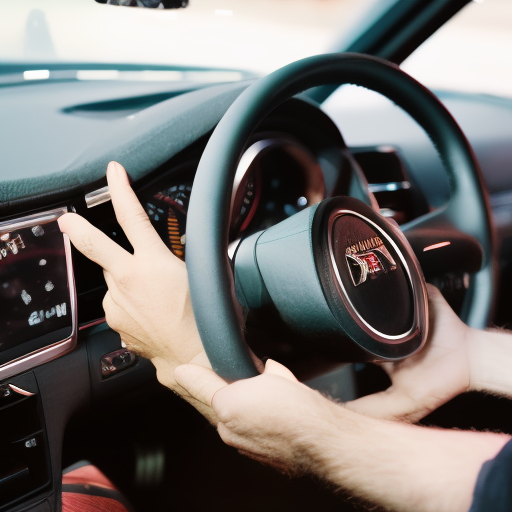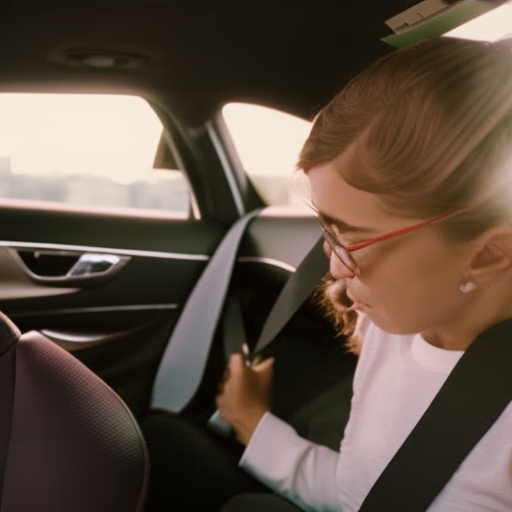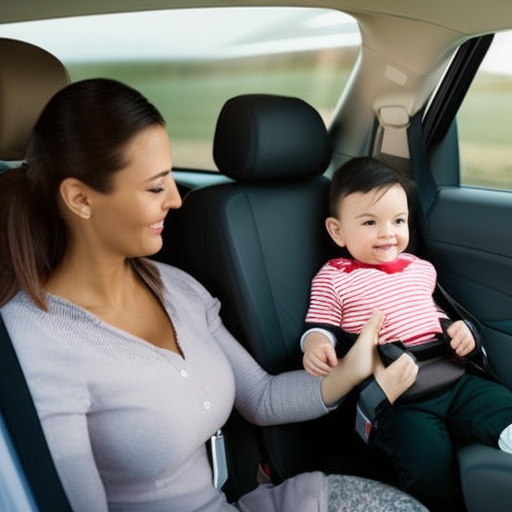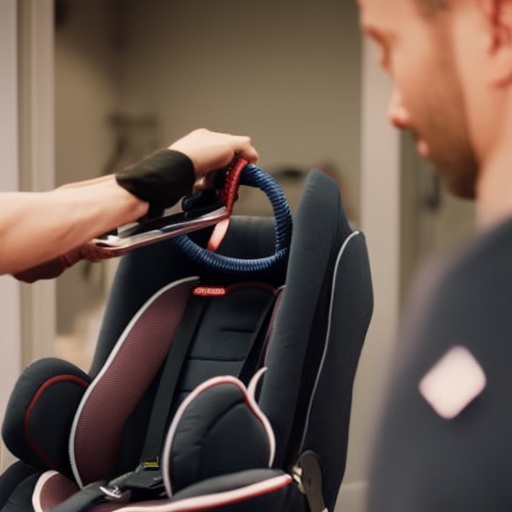"Cherishing Little Steps - A Haven for Baby and Family Journeys"
Car Seat Installation Guide
Are you feeling overwhelmed by the thought of installing a car seat? Don’t worry, we’ve got you covered with our Car Seat Installation Guide.
We understand that the idea of installing a car seat can be intimidating, but we’re here to help make it easier for you. Our guide will walk you through each step of the process, from choosing the right car seat to securing it properly in your vehicle.
With our easy-to-follow instructions and helpful tips, you’ll have the peace of mind knowing that your little one is safe and secure on every journey.
So, let’s get started and ensure your child’s safety on the road!
Key Takeaways
- Choose a car seat that matches your child’s age, weight, and height.
- Read the car seat manual carefully and follow the manufacturer’s instructions for installation.
- Ensure the car seat is securely fastened in your vehicle.
- Regularly inspect the car seat for wear, damage, or safety updates.
Types of Car Seats

When installing a car seat, it’s important to familiarize yourself with the different types of car seats available to ensure the safety and proper installation of the seat. There are three main types of car seats: infant car seats, convertible car seats, and booster seats.
Infant car seats are designed for newborns and infants up to a certain weight and height. They’re rear-facing and provide the best protection for young children. Convertible car seats can be used in both rear-facing and forward-facing positions. They’re suitable for infants and toddlers and can be adjusted as your child grows. Booster seats are for older children who’ve outgrown their convertible car seats. They help position the seat belt correctly on the child’s body for optimal safety.
When installing a car seat, always follow the manufacturer’s instructions and the car seat safety guidelines. Ensure that the seat is securely installed and properly adjusted for your child’s size and age. Remember to tighten the seat belt or latch system and check for any movement or looseness. Check that the harness straps are snug and properly positioned on your child’s shoulders. Regularly inspect the car seat for any signs of wear or damage and replace it if necessary.
These different types of car seats provide varying levels of protection for your child. By understanding the types of car seat installation and following the car seat safety guidelines, you can ensure the safety of your child while traveling in a vehicle.
Choosing the Right Car Seat

To ensure the safety and proper installation of your car seat, it’s crucial that you choose the right car seat for your child’s age, weight, and height. When choosing a car seat, it’s important to consider the safety features it offers. Look for seats that have a five-point harness system, side-impact protection, and energy-absorbing foam. These features provide additional protection and reduce the risk of injury in the event of a crash.
Another key factor to consider is the age and weight recommendations provided by the car seat manufacturer. Different car seats are designed to accommodate children of different ages and sizes. For infants, rear-facing car seats are recommended as they provide the best protection for their delicate neck and spine. As your child grows, you can transition to a forward-facing car seat and later to a booster seat.
Remember that car seats have expiration dates, so it’s important to check the manufacturer’s recommendations for the lifespan of the seat. Additionally, always follow the installation instructions provided by the car seat manufacturer and make sure the seat is securely fastened in your vehicle.
Reading the Car Seat Manual

Before installing your car seat, it is essential that you carefully read the car seat manual. Reading the manual ensures that you have a complete understanding of the installation process and the specific requirements for your car seat model. It also helps you familiarize yourself with important safety guidelines that will help protect your child in the event of an accident.
To assist you in your reading comprehension, here is a helpful table summarizing some key car seat safety guidelines:
| Guideline | Description | Importance |
|---|---|---|
| Proper installation | Ensure the car seat is securely installed | Proper installation reduces the risk of injury |
| Correct harness adjustment | Ensure the harness fits snugly around | Proper harness adjustment keeps your child secure |
| Regular inspection and maintenance | Regularly inspect and maintain the car seat | Inspections help identify any issues or damage early |
Preparing the Car for Installation

To ensure a secure installation of your car seat, begin by checking the compatibility of your car’s seat belts with the car seat requirements. This step is crucial to ensure that your car seat will be properly secured and that your child will be safe during travel.
Here are some common mistakes to avoid when preparing your car for installation:
-
Clear the area: Before installing the car seat, remove any loose objects from the backseat that could become projectiles in the event of a crash. This includes toys, books, and other items that could potentially harm your child.
-
Adjust the seat: Make sure the car’s seat is properly adjusted to accommodate the car seat. Check the car seat manual for specific instructions on how the seat should be positioned. Improper seat adjustment can affect the stability and security of the car seat.
-
Check for levelness: Use a level to ensure that the car seat is installed on a level surface. This will help prevent the car seat from tilting or shifting during travel.
-
Follow the manufacturer’s instructions: Each car seat will have specific installation instructions provided by the manufacturer. It’s important to carefully read and follow these instructions to ensure a proper and secure installation.
Installing a Rear-Facing Car Seat
Start by positioning the rear-facing car seat in the backseat of your vehicle. Make sure it’s centered and secured tightly. Check the car seat’s manual for specific instructions on how to properly install it.
The rear-facing position is crucial for your child’s safety, as it provides better protection for their head, neck, and spine. To ensure a secure installation, use the vehicle’s seat belt or LATCH system, following the manufacturer’s guidelines. The seat shouldn’t move more than one inch in any direction when tested at the base.
Double-check the seat’s recline angle, aiming for a 45-degree angle to provide optimal protection. Additionally, make sure the harness straps are at or below your child’s shoulders and are snug enough that you can only fit one finger between the strap and your child’s collarbone.
Always refer to the car seat’s manual for specific instructions on rear-facing car seat installation and safety. By correctly installing and using a rear-facing car seat, you’re taking an essential step in protecting your child during car rides.
Installing a Forward-Facing Car Seat

Position the forward-facing car seat securely in the backseat of your vehicle. This is an important step to ensure the safety of your child during car rides.
Here are some guidelines to follow for proper positioning of a forward-facing car seat:
-
Place the car seat in the center of the backseat, if possible. This provides the most protection in the event of a side impact collision.
-
Make sure the car seat is level. Use the built-in level indicator or adjust the recline angle according to the manufacturer’s instructions.
-
Attach the car seat using the vehicle’s seat belt or LATCH system. Follow the manual carefully to ensure a tight and secure installation.
-
Check for proper installation by giving the car seat a firm tug. It shouldn’t move more than an inch in any direction.
Remember, always consult the car seat’s manual and your vehicle’s owner’s manual for specific instructions and requirements. It’s crucial to follow them to ensure your child’s safety.
Regularly check the car seat for any signs of wear or damage, and replace it if necessary. By properly installing a forward-facing car seat, you can provide your child with a safe and secure ride every time.
Installing a Booster Seat

How can you ensure a secure and comfortable installation of a booster seat for your child?
Booster seat safety is of utmost importance when it comes to protecting your child during car rides. To guarantee a secure installation, start by checking the booster seat weight limits. Make sure that your child meets the minimum weight requirement before using a booster seat. It’s crucial to follow the manufacturer’s guidelines regarding weight limits to ensure optimal safety.
Next, position the booster seat in the back seat of your vehicle. Place it in a seating position with a lap and shoulder belt. Ensure that the booster seat is properly aligned with your child’s shoulders and hips. The seat belt should fit snugly across your child’s chest and shoulder, without restraining their movement.
To further enhance safety, check that the lap belt sits low on the hips and upper thighs, rather than across the abdomen. This positioning helps to distribute the force of a crash more effectively. Remember to tighten the seat belt to eliminate any slack.
Securing the Car Seat With LATCH

You should always ensure a secure and comfortable installation of your car seat by regularly using the LATCH system. The LATCH system, which stands for Lower Anchors and Tethers for Children, is a standardized system that provides an additional method of securing your car seat.
Here are four important things to keep in mind when installing your car seat with LATCH:
-
Check for LATCH compatibility: Before you begin, make sure your car seat and vehicle are equipped with the LATCH system. Look for the LATCH anchors in your vehicle and check your car seat’s manual to confirm it’s LATCH compatible.
-
Locate the LATCH anchors: In most vehicles, the LATCH anchors are located in the rear seat. They’re typically marked with labels or symbols. Take a moment to familiarize yourself with the location of these anchors before starting the installation process.
-
Attach the lower anchors: Secure the car seat’s lower anchors to the LATCH anchors in your vehicle. Push the car seat firmly into the seat and tighten the straps to ensure a snug fit. Double-check that the car seat is securely attached by giving it a firm tug.
-
Use the top tether: For forward-facing car seats, use the top tether to provide an additional level of stability. Attach the top tether to the designated anchor point in your vehicle and tighten it to remove any slack. This will help prevent the car seat from moving forward in the event of a sudden stop or crash.
Securing the Car Seat With Seat Belts

Secure your car seat using the seat belts for a safe and reliable installation. While LATCH is a popular method, using seat belts can be just as effective. It’s important to follow the manufacturer’s instructions and your vehicle’s manual when securing the car seat with seat belts.
Here are some alternative installation methods to consider:
-
Locking clip: If your vehicle’s seat belts don’t automatically lock, you may need to use a locking clip to secure the car seat. This small metal device helps prevent the seat belt from loosening during a crash.
-
Vehicle belt path: Some car seats have a separate belt path specifically for seat belt installation. This ensures a secure fit and prevents any twisting or tangling of the seat belt.
-
Forward-facing tether: If you have a forward-facing car seat, using the tether strap can provide additional stability. This strap attaches to an anchor point in your vehicle to prevent the seat from moving forward in a collision.
When securing your car seat with seat belts, there are common mistakes to avoid:
-
Twisted seat belts: Make sure the seat belts aren’t twisted and lay flat against the car seat.
-
Loose installation: Ensure a tight and secure installation by pulling the seat belt tight and pushing down on the car seat while tightening.
-
Improper belt placement: The seat belt should be threaded through the correct belt path and not interfere with any other components of the car seat.
Positioning and Adjusting the Car Seat
To ensure proper installation and optimal safety, position and adjust your car seat according to the manufacturer’s guidelines. Here are four important steps to follow:
-
Adjust the Harness:
Check that the harness straps are at the correct height for your child. In rear-facing mode, the straps should be positioned at or below your child’s shoulders. In forward-facing mode, the straps should be positioned at or above the shoulders. Make sure the harness is snug, with no slack. You shouldn’t be able to pinch any excess strap material. -
Set the Recline Position:
Depending on your car seat and your child’s age, you may need to adjust the seat’s recline position. For newborns and infants, the seat should be in the most reclined position to support their developing neck and spine. As your child grows, you can gradually increase the seat’s upright position, ensuring their comfort and safety. -
Check for Proper Installation:
Once you’ve adjusted the harness and recline position, ensure that the car seat is securely installed in your vehicle. Double-check that the seat is tightly and correctly fastened using either the seat belt or the LATCH system. Give the car seat a firm shake to make sure there’s minimal movement. -
Regularly Recheck and Adjust:
As your child grows, continue to check and adjust the harness and recline position to ensure their safety and comfort. Always follow the manufacturer’s guidelines for proper positioning and adjustments.
Testing the Car Seat Installation
Make sure that the car seat installation is properly tested to ensure the safety and security of your child. Testing the car seat installation is an essential step to ensure that the seat is installed correctly and will effectively protect your child in case of an accident. Here are some important steps to follow when testing the car seat installation:
| Testing Steps | Troubleshooting Issues |
|---|---|
| Push and Pull Test | Loose or unstable seat |
| Side-to-Side Test | Excessive movement |
| Recline Angle Test | Incorrect recline angle |
| Harness Test | Loose or twisted straps |
Perform a push and pull test to check if the car seat is securely installed. Apply force in opposite directions to ensure that the seat remains stable. If the seat is loose or unstable, consult the car seat manual for proper installation instructions.
Next, perform a side-to-side test to check for excessive movement. The car seat should not move more than an inch in any direction. If there is excessive movement, double-check the installation and tighten the seat belts or LATCH system as needed.
Check the recline angle of the car seat using the recline angle indicator provided by the manufacturer. Ensure that the seat is reclined at the correct angle to provide optimal safety for your child.
Finally, test the harness by buckling your child into the car seat and tightening the straps securely. The harness should fit snugly against your child’s body without any twists or slack.
Additional Safety Tips and Considerations

For optimal safety, always ensure that you have properly installed and secured the car seat using the recommended guidelines. In addition to following the basic installation steps, there are a few additional safety tips and considerations to keep in mind:
-
Take advantage of additional safety features: Many car seats come with extra safety features that can provide added protection for your child. These may include side-impact protection, energy-absorbing foam, or anti-rebound bars. Make sure to familiarize yourself with these features and use them correctly to enhance your child’s safety.
-
Double-check the installation: Even if you think you’ve installed the car seat correctly, it’s always a good idea to double-check. Give the seat a firm tug to ensure it doesn’t move more than an inch in any direction. Also, make sure the harness straps are snug and properly positioned on your child.
-
Avoid common installation mistakes: There are a few common mistakes that parents often make when installing car seats. These include not securing the seat tightly enough, using the wrong angle for rear-facing seats, or not adjusting the harness straps properly. Take the time to read the instruction manual carefully and follow all the guidelines to avoid these pitfalls.
-
Regularly inspect the car seat: Car seats can undergo wear and tear over time, which can affect their safety. Regularly inspect the seat for any signs of damage, such as frayed straps or cracked plastic. Also, check for recalls or safety updates from the manufacturer and make sure to register your car seat to receive important notifications.
Frequently Asked Questions
How Do I Know if My Car Seat Is Installed Correctly?
To check if your car seat is installed correctly, look for common mistakes like loose straps or incorrect harness height. Ensure the seat is tightly secured and the base is level. It’s crucial for your child’s safety.
Can I Use a Car Seat That Has Been Involved in a Previous Accident?
Yes, you can use a car seat that has been involved in a previous accident. However, it is essential to have it inspected by a professional during a car seat safety check. Proper car seat installation is crucial for your child’s safety.
Is It Safe to Use a Second-Hand Car Seat?
Using a second-hand car seat has its pros and cons. While it can save you money, you need to ensure it’s in good condition and has been properly maintained. Your child’s safety should always be your top priority.
What Is the Weight Limit for a Rear-Facing Car Seat?
You might be wondering about the weight limit for a rear-facing car seat. Well, it’s important to know that rear-facing car seats typically have weight limits ranging from 20 to 40 pounds.
Can I Install a Car Seat in the Front Seat of My Vehicle?
Yes, you can install a car seat in the front seat of your vehicle. However, it is important to follow car seat safety regulations and guidelines to ensure the safety of your child.
Conclusion
By following this comprehensive car seat installation guide, you can ensure the safety of your little ones during every car ride. Imagine the peace of mind and comfort you’ll feel as you buckle them snugly into their properly installed car seat.
With careful attention to the steps outlined in this guide, you can confidently navigate the road knowing that you’ve taken every precaution to protect your precious cargo.
Remember, safety should never be compromised when it comes to your children.



I enjoyed it just as much as you will be able to accomplish here. You should be apprehensive about providing the following, but the sketch is lovely and the writing is stylish; yet, you should definitely return back as you will be doing this walk so frequently.
Thanks for sharing. I read many of your blog posts, cool, your blog is very good.